What is RCS messaging and how to use it in conversational messaging?
Engage in smarter, more dynamic customer conversations with seamless cross-platform messaging, powered by RCS.
Contents
Welcome to the era of Rich Communication Services (RCS). First released in 2008, RCS has since redefined how more than a billion Android users stay connected.
And now, after years of campaigning by industry regulators and leading mobile brands like Google and Samsung, the successor to SMS is finally coming to iPhones where Apple now supports RCS as part of their iOS 18 release in September. This means iPhone and Android users can engage in seamless cross-platform multimedia messaging—no additional apps required. This update will make RCS messaging available to more than 1.5 billion new users, making it the ideal time to join the conversation by adding it to your brand’s omnichannel messaging strategy.
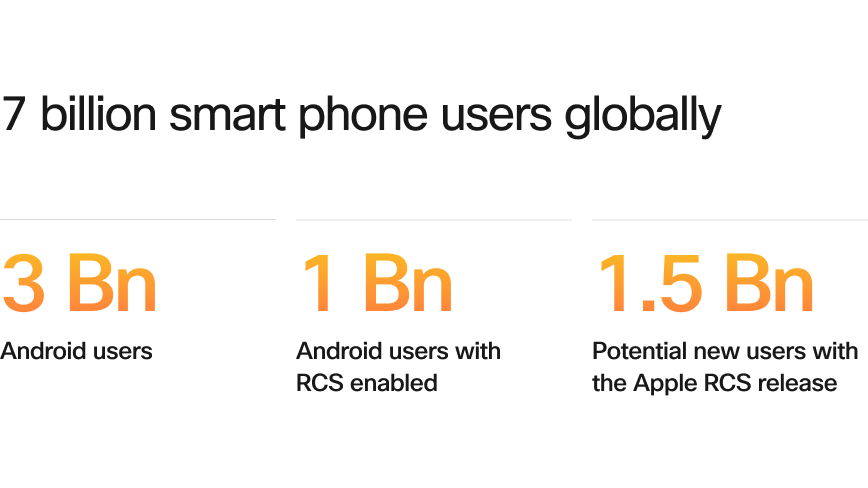
What is RCS messaging?
RCS is a communication protocol that upgrades the traditional SMS experience by enabling richer, more interactive messaging features. Similar to what users experience with popular messaging apps like WhatsApp or Facebook Messenger. However unlike these apps, RCS uses the mobile device’s native messaging app, so users needn’t download a third-party app or register their details to use RCS messaging.
What is RCS chat?
An RCS chat is a conversation that includes one or more RCS messages. You may have noticed when you open a conversation in your native messaging app, you will sometimes see 'RCS chat with X'. And where you type your message it says 'RCS message'. This means you are using RCS! RCS conversations enable you to send and receive rich media, see when someone is typing, and get read receipts.
RCS features
To fully leverage RCS messaging to drive conversational messaging you need to know about the stand out RCS chat features.
Rich messaging capabilities: Within an RCS chat or group chat share high-resolution media, including gifs, image carousels, and dynamic media cards.
Live engagement indicators: See when a contact is typing in real-time and if and when they’ve read your messages with timed, on-screen read receipts.
Interactive actions: Enhance engagement within RCS messages using suggested replies and contextual buttons that trigger pre-defined outcomes.
Cross-app integrations: Add third-party app functionality to your customer conversations, such as digital wallets and map sharing.
How to turn on RCS
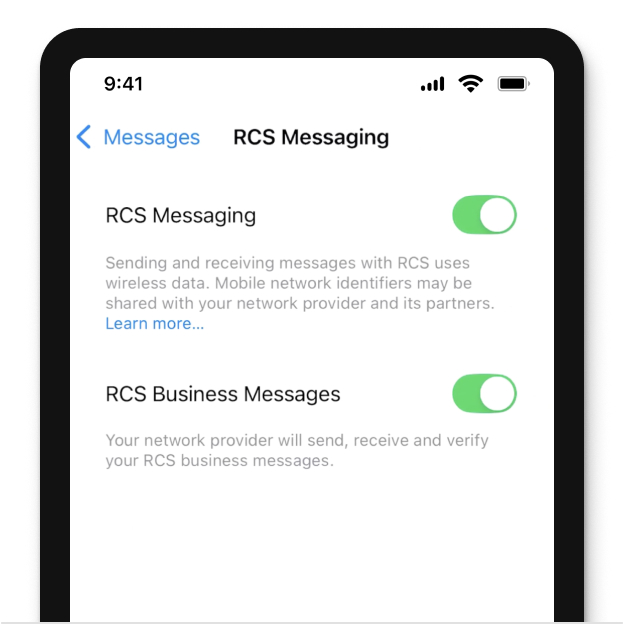
After upgrading to iOS 18, Apple users will have RCS messaging enabled by default – so you don’t have to do a thing to start receiving RCS messages. While RCS messaging is enabled by default, you can change this in your device settings if you have an iPhone, or if you have an Android device within your messages under chat features.
Download our eGuide to discover the value that RCS brings to mobile messaging and why businesses should adopt it.
RCS vs SMS
SMS remains one of the most effective ways to directly engage with customers at scale with timely updates and notifications. However RCS messaging offers a far more dynamic and engaging messaging experience, purpose-built for the data-driven smartphone era.
Let’s take a look at the key differences between RCS vs SMS to see how it can help you deliver more meaningful customer interactions, when and where it matters most.
SMS
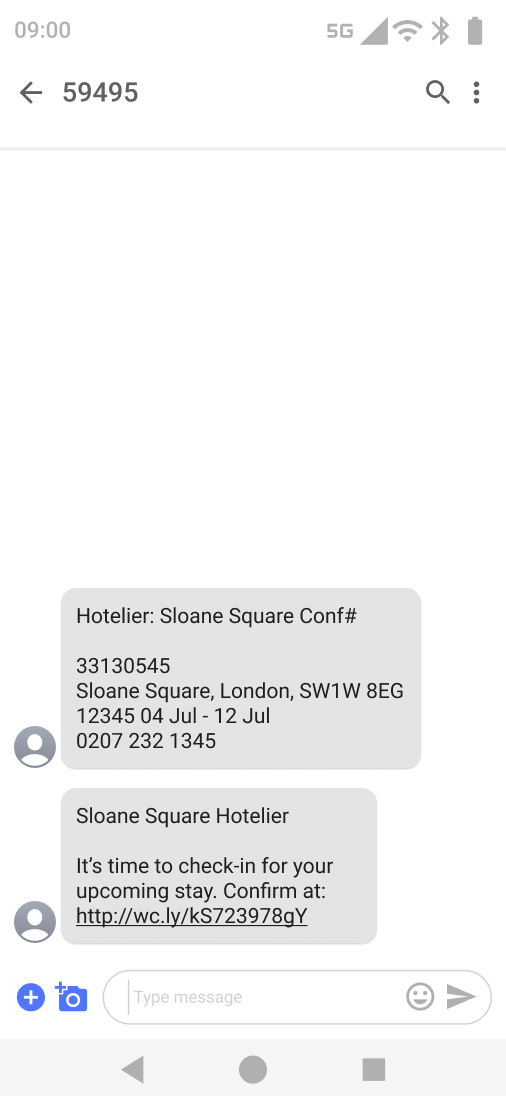
Reach: All mobile phone devices support SMS.
Connectivity: No internet connection is required to send and receive SMS texts as it only uses the device’s cellular network.
Installation: SMS will always work out-of-the-box with your device’s native messaging app; no additional download required.
Text length: SMS restricts all texts to 160 characters per message.
Media support: You cannot send image, audio, and video files with SMS.
Interface: SMS is restricted by the protocol’s default text formatting.
RCS
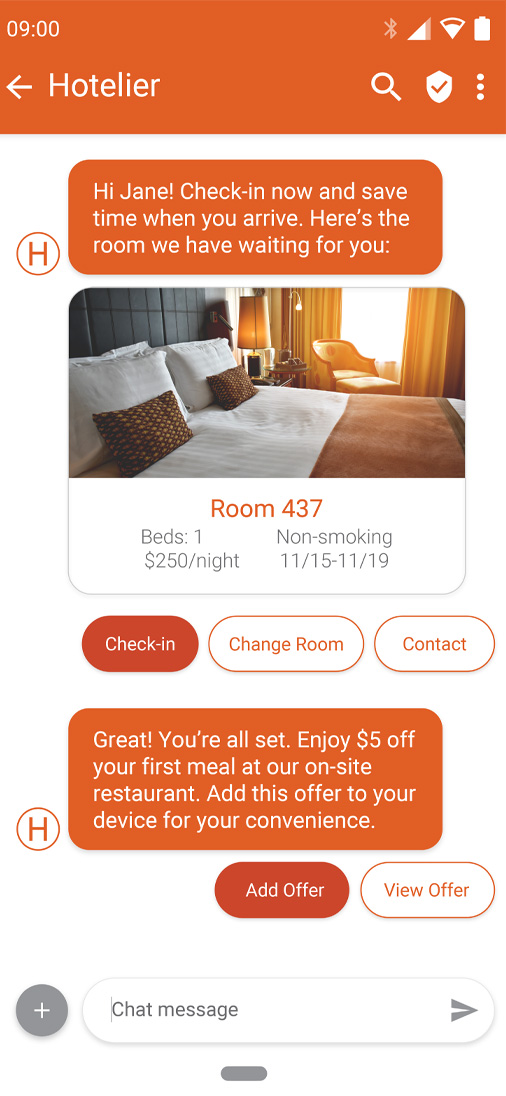
Reach: RCS has more than 1 billion active monthly users worldwide, with room for expansive growth when the channel launches on iPhone later this year.
Connectivity: RCS requires an internet connection—either through Wi-Fi or mobile data provider. If there is no internet available, the RCS protocol will use the SMS channel.
Installation: Like SMS, there’s no need to download an app to use RCS. You can use it right away with your Android device’s default texting app.
Text length: RCS allows up to 250,000 characters per message.
Media support: RCS messaging supports high-resolution media files, including images, audio, and video.
Interface: RCS features a diverse range of interactive formats and media interfaces, such as image carousels, media cards, suggested replies, and branded logos and banners.
So which channel should you go for, RCS or SMS? The answer is both! We like to think of RCS messaging as an extension of SMS, with the benefit of tackling some of the pitfalls in SMS.
How to master conversational messaging with RCS
Today's connected customers increasingly expects personalized, joined-up interactions with the brands they use, that both inform and add value. They also want more control over how they engage with brands, such as having the ability to self-serve where possible.
By integrating RCS messaging with your backend systems, you can build unique customer profiles that help you to more easily personalize customer journeys, in turn driving higher brand loyalty and message engagement rates. For example, you could use RCS to:
Enhance promotional marketing: Share personalized offers that customers can redeem in-channel with a single button press. For instance, a restaurant might send free dessert vouches to consenting customers on their birthday, which can be saved for later by pressing “add to wallet.”
Share interactive service updates: Let customers easily respond to contextual updates, such as requesting an order is sent to an alternative address in response to a dispatch alert, or confirming their plans to attend an appointment in response to an automated reminder.
Integrate transactional experiences: Enable customers to browse, view, and purchase goods and services in-channel—such as in response to a personalized promotional offer—using image carousels, video cards, and their preferred payment methods.
For more support on how to leverage RCS and drive engagement check out these useful reads:
RCS chatbot best practices
Integrate automated chatbots with RCS to field basic queries and self-service requests, freeing contact center resources for more valuable tasks. Before any design or concept work is done, start with the basics to improve your RCS messaging experience:
1. Be clear about what the RCS chatbot does
It’s easy for users to assume that a chatbot can help them with any request they can think of, but that’s not the current, functional reality of most chatbots. Set user expectations upfront and let them know what this bot is designed to do (i.e. “Help finding tickets”, “Search store locations”, “Take our style quiz”, etc.). When users can easily understand what the bot does and how it can help them meet their goal, they’ll be more satisfied and likely to return.
2. Provide an optimal experience
As chatbots continue to become more commonplace, it’s paramount that brands build their chatbot conversations around strong design principles that satisfy consumer expectations and efficiently complete tasks. We know there’s nothing worse for a user than to find themselves in an endless loop with a poorly designed chatbot and no way out! Make sure all buttons and commands presented by the RCS chatbot are actionable.
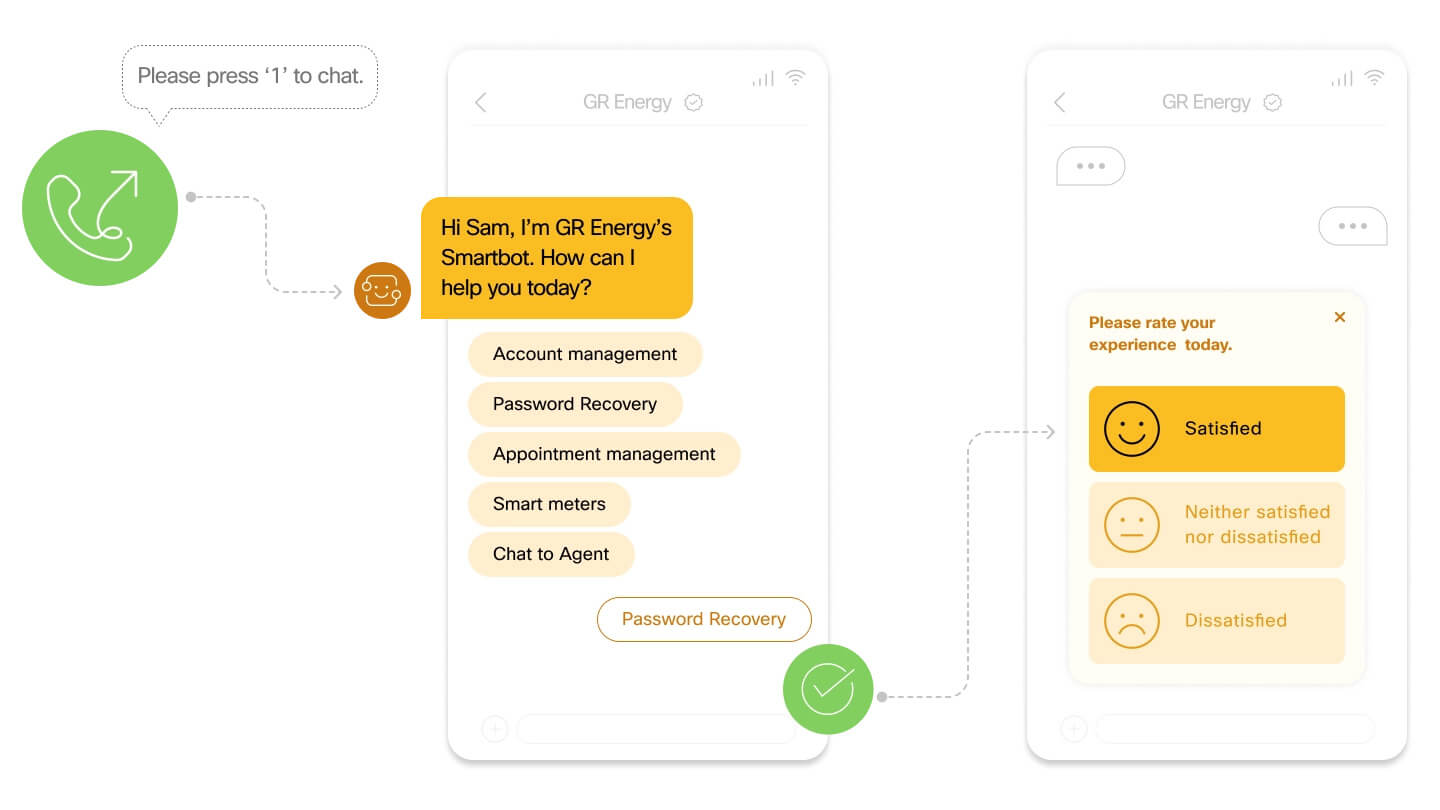
3. Always have a human fallback option
Be sure to have an option that connects the customer with a human for situations where the chatbot cannot resolve your customer’s query.
Implementing a suggested action chip such as “Contact us” or “Call Customer Support” is an easy way to let the user know that they always have a way to get in touch with a human representative if needed.
4. Provide suggestions to steer users
Suggested actions and replies are great new features that come built into RCS. Utilizing these actions and reply capabilities will help the user navigate the conversation by keeping the momentum and ensuring the conversation flows.
5. Your RCS chatbot should reflect the brand
If your brand were a person, how would it speak? What kind of language would it use? Would it use emojis? Incorporating your brand voice into the conversation keeps the RCS chatbot consistent with your other marketing channels and strengthens user confidence that they are interacting with a trusted brand that they are familiar with.
How to get started with RCS messaging
Before you get started with RCS messaging, we recommend asking the following questions of your organization and its messaging strategy. These will help you assess any challenges and opportunities, and more clearly identify what you can achieve with RCS:
How are your competitors using RCS, if at all, and what can that tell you about your existing approach’s strengths and weaknesses?
What are the low-risk, high-reward use cases that could help you demonstrate the value of RCS?
What would your organization ideally require from an RCS provider—and how might they need to support you as you scale your messaging strategy?
Do you have all the data points to help inform next steps to see when and where each channel is most effective?
Whatever these questions reveal, we can help.
Webex Connect is an enterprise-grade Communications Platform as a Service (CPaaS) solution that lets you build and automate joined-up customer journeys across the latest digital channels (and that includes RCS chat). Its low-code visual journey builder and library of pre-built integrations mean even non-technical users can start building meaningful interactions right out of the box.
Together, we can help you get started on your RCS journey, and refine your strategy over time to ensure you’re always getting the most from your conversational messaging.
To learn more about RCS and Webex Connect, please get in touch.
Frequently asked questions
-
What is an RCS chat?
Rich Communication Services (RCS) is a modern messaging protocol that enhances the traditional SMS experience. It offers richer, more interactive messaging capabilities allowing you to send high-resolution media, see live engagement indicators like typing and read receipts. RCS uses your mobile device’s native messaging app, so there's no need to download a third-party app or register for it.
-
What is the difference between SMS and RCS?
The key differences between SMS and RCS are:
Reach: SMS is supported by all mobile devices, while RCS currently has over 1 billion active users and is expanding.
Connectivity: SMS uses the cellular network and doesn’t require an internet connection, whereas RCS needs Wi-Fi or mobile data.
Text Length: SMS is limited to 160 characters per message, while RCS allows up to 250,000 characters.
Media Support: SMS cannot send media files, but RCS supports high-resolution images, audio, and video.
Interface: SMS is limited to basic text formatting, whereas RCS offers interactive formats like image carousels, media cards, and branded logos.
-
Is RCS more secure than SMS?
RCS offers enhanced security features compared to SMS. It supports end-to-end encryption for one-on-one chats, ensuring that your messages are secure and private. SMS is prone to phishing scams making it difficult for recipients to detect, where RCS offers a verified business profile and custom branding so users will more likely trust messages sent via RCS.
-
Why do messages switch from RCS to SMS?
Messages may switch from RCS to SMS for several reasons:
1. Internet connectivity: RCS requires an internet connection, either through Wi-Fi or mobile data. If your device loses internet access, it will automatically switch to SMS to ensure your message is delivered.
2. Recipient compatibility: The recipient's device must also support RCS. If they are using a device or carrier that does not support RCS, the message will default to SMS.
3. Carrier or network issues: Sometimes, network or carrier-specific issues can cause RCS messages to fail, prompting the device to send the message via SMS instead.
4. Temporary service disruptions: Occasional service disruptions or maintenance on the RCS network can also result in messages being sent as SMS.
-
Is RCS messaging worth it?
Absolutely. RCS provides a dynamic and engaging messaging experience. It allows for richer media sharing, interactive actions, and real-time engagement indicators, making it ideal for businesses looking to enhance customer interactions. With its growing user base, especially with the recent release of Apple supporting RCS, it is a valuable addition to any omnichannel messaging strategy.